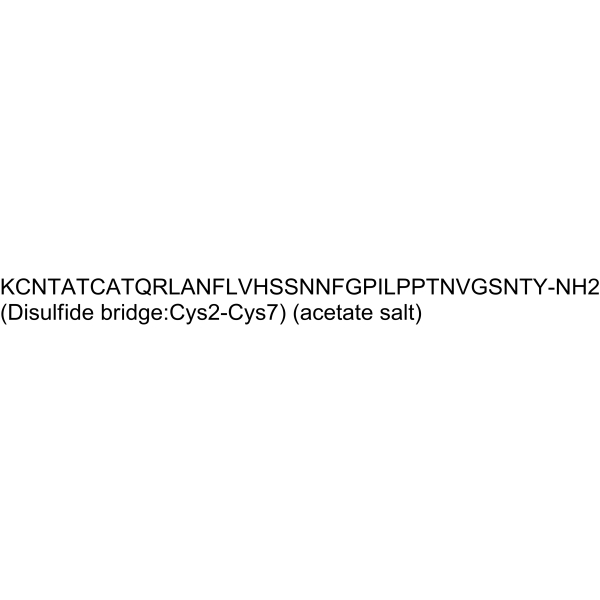
| 规格 | 价格 | 库存 | 数量 |
|---|---|---|---|
| 1mg |
|
||
| 5mg |
|
||
| 10mg |
|
||
| 50mg |
|
||
| Other Sizes |
|
| 靶点 |
Anticancer; amylin analog; diabetes
|
|---|---|
| 体外研究 (In Vitro) |
普兰林肽以剂量依赖性方式抑制 HCT-116 和 HT-29 的生长,并且对后者的疗效更强(IC50 值分别为 48.67 和 9.10 μg/mL)[1]。当 HCT-116 和 HT-29 中添加 5、10 和 20 μg/mL 的普兰林肽时,可协同诱导 5-氟尿嘧啶、奥沙利铂或伊立替康的抗增殖作用 [1]。
|
| 细胞实验 |
MTT试验[1]
将HCT-116(野生型p53)和HT-29(突变型p53)细胞以200 μL的培养基密度5×103接种于96孔板中,孵育并贴壁过夜。分别用pramlintide (0-102.4 μg/mL)、5- fu (0-200 μM)、OXA (0-300 μM)或IRN (0-160 μM)单独或联合3种不同浓度的pramlintide(5、10、20 μg/mL)(对应HT-29中的0.5×IC50、IC50和2×IC50)对贴壁细胞进行处理。在培养基中单独生长的细胞(仅用普兰林肽处理)或含有等量DMSO的细胞作为对照(用于其他处理条件)。[1] 将细胞与指定浓度的药物孵育72小时。所有的测量都是一式三份。然后,按照制造商的方案进行细胞增殖试验。简单地说,将MTT染料以0.5 mg/mL的终浓度加入PBS中。37℃孵育3小时,丢弃MTT,每孔加入100 μL DMSO溶解甲醛产物,摇匀5分钟。然后,使用酶联免疫吸附测定板阅读器在570 nm处读取,参考波长为690 nm。细胞活力计算公式为:实验组吸光度/对照组吸光度。IC50值定义为使细胞活力降低50%所需的浓度。使用Compusyn软件1.0进行剂量效应分析和IC50计算。 |
| 参考文献 | |
| 其他信息 |
To investigate the synergistic potential of pramlintide with chemotherapy agents in colorectal cancer cell lines, we sought to test three different concentrations of pramlintide that correspond to 0.5×IC50, IC50, and 2×IC50 in each cell line. Nevertheless, due to high concentration requirements in HCT-116 cell lines, the limited amount of the drug available, and to be consistent with the investigated comparisons, we utilized pramlintide at concentrations of 5, 10, and 20 μg/mL, which correspond to 0.5×IC50, IC50, and 2×IC50 in HT-29. We demonstrated for the first time that at low and clinically achievable concentrations, pramlintide could synergistically inhibit colorectal cancer cell proliferation in HCT-116 and HT-29 cell lines when combined with 5-FU, OXA, and IRN in a concentration-dependent manner. These results suggest that pramlintide is a novel potential adjuvant anticancer agent with beneficial role in overcoming resistance to 5-FU, OXA, and IRN. Further in vivo and clinical studies are required to establish pramlintide as a valid chemopreventive and chemotherapeutic agent in colorectal cancer. [1]
Despite the promising results we obtained from this study, there were some limitations. First, the antineoplastic potential of pramlintide was tested only using the short-term MTT assay. Second, we utilized only two representative cell lines to investigate the differential effect of pramlintide based on the p53 status; thus, the difference in the response to pramlintide between HT-29 and HCT-116 could be due to factors other than p53. [1] Conclusion This study shows for the first time that pramlintide has anticancer activity against colorectal cancer and has a synergistic effect with 5-FU, OXA, and IRN. Future work will more fully explore the antiproliferative mechanisms of pramlintide and the underlying molecular mechanisms of synergism. Moreover, the antineoplastic potential of pramlintide will be analyzed using other long-term assays, such as colony-forming assay, and in vivo models of colorectal cancer. [1] |
| 分子式 |
C173H271N51O55S2
|
|---|---|
| 分子量 |
4009.44157624245
|
| 精确质量 |
4007.9451
|
| CAS号 |
187887-46-3
|
| 相关CAS号 |
Pramlintide;151126-32-8;Pramlintide TFA
|
| PubChem CID |
118984456
|
| 序列 |
Lys-Cys-Asn-Thr-Ala-Thr-Cys-Ala-Thr-Gln-Arg-Leu-Ala-Asn-Phe-Leu-Val-His-Ser-Ser-Asn-Asn-Phe-Gly-Pro-Ile-Leu-Pro-Pro-Thr-Asn-Val-Gly-Ser-Asn-Thr-Tyr-NH2 (Disulfide bridge:Cys2-Cys7); H-Lys-Cys(1)-Asn-Thr-Ala-Thr-Cys(1)-Ala-Thr-Gln-Arg-Leu-Ala-Asn-Phe-Leu-Val-His-Ser-Ser-Asn-Asn-Phe-Gly-Pro-Ile-Leu-Pro-Pro-Thr-Asn-Val-Gly-Ser-Asn-Thr-Tyr-NH2.CH3CO2H; L-lysyl-L-cysteinyl-L-asparagyl-L-threonyl-L-alanyl-L-threonyl-L-cysteinyl-L-alanyl-L-threonyl-L-glutaminyl-L-arginyl-L-leucyl-L-alanyl-L-asparagyl-L-phenylalanyl-L-leucyl-L-valyl-L-histidyl-L-seryl-L-seryl-L-asparagyl-L-asparagyl-L-phenylalanyl-glycyl-L-prolyl-L-isoleucyl-L-leucyl-L-prolyl-L-prolyl-L-threonyl-L-asparagyl-L-valyl-glycyl-L-seryl-L-asparagyl-L-threonyl-L-tyrosinamide (2->7)-disulfide acetic acid
|
| 短序列 |
KCNTATCATQRLANFLVHSSNNFGPILPPTNVGSNTY-NH2 (Disulfide bridge:Cys2-Cys7); KCNTATCATQRLANFLVHSSNNFGPILPPTNVGSNTY
|
| 外观&性状 |
White to off-white solid powder
|
| tPSA |
1780Ų
|
| 氢键供体(HBD)数目 |
57
|
| 氢键受体(HBA)数目 |
61
|
| 可旋转键数目(RBC) |
110
|
| 重原子数目 |
281
|
| 分子复杂度/Complexity |
9690
|
| 定义原子立体中心数目 |
41
|
| SMILES |
S1C[C@@H](C(N[C@@H](C)C(N[C@@H]([C@@H](C)O)C(N[C@@H](CCC(N)=O)C(N[C@H](C(N[C@H](C(N[C@@H](C)C(N[C@@H](CC(N)=O)C(N[C@@H](CC2C=CC=CC=2)C(N[C@@H](CC(C)C)C(N[C@@H](C(C)C)C(N[C@@H](CC2=CNC=N2)C(N[C@@H](CO)C(N[C@@H](CO)C(N[C@@H](CC(N)=O)C(N[C@@H](CC(N)=O)C(N[C@@H](CC2C=CC=CC=2)C(NCC(N2CCC[C@H]2C(N[C@@H]([C@@H](C)CC)C(N[C@@H](CC(C)C)C(N2CCC[C@H]2C(N2CCC[C@H]2C(N[C@H](C(N[C@H](C(N[C@H](C(NCC(N[C@H](C(N[C@H](C(N[C@H](C(N[C@H](C(N)=O)CC2C=CC(=CC=2)O)=O)[C@@H](C)O)=O)CC(N)=O)=O)CO)=O)=O)C(C)C)=O)CC(N)=O)=O)[C@@H](C)O)=O)=O)=O)=O)=O)=O)=O)=O)=O)=O)=O)=O)=O)=O)=O)=O)=O)=O)CC(C)C)=O)CCCNC(=N)N)=O)=O)=O)=O)NC([C@H]([C@@H](C)O)NC([C@H](C)NC([C@H]([C@@H](C)O)NC([C@H](CC(N)=O)NC([C@H](CS1)NC([C@H](CCCCN)N)=O)=O)=O)=O)=O)=O.OC(C)=O
|
| InChi Key |
DTPWZYSUQQHRKD-VIUAGAKSSA-N
|
| InChi Code |
InChI=1S/C171H267N51O53S2.C2H4O2/c1-21-81(12)130(163(268)207-110(56-78(6)7)169(274)222-53-33-42-118(222)170(275)221-52-32-41-117(221)160(265)219-135(89(20)230)167(272)206-109(66-125(180)238)151(256)212-128(79(8)9)161(266)186-68-126(239)192-111(70-223)154(259)203-107(64-123(178)236)152(257)218-134(88(19)229)166(271)195-98(136(181)241)57-92-43-45-94(231)46-44-92)214-159(264)116-40-31-51-220(116)127(240)69-187-141(246)101(58-90-34-24-22-25-35-90)199-148(253)105(62-121(176)234)201-149(254)106(63-122(177)235)202-155(260)112(71-224)209-156(261)113(72-225)208-146(251)103(60-93-67-184-75-188-93)205-162(267)129(80(10)11)213-150(255)100(55-77(4)5)198-145(250)102(59-91-36-26-23-27-37-91)200-147(252)104(61-120(175)233)196-137(242)82(13)189-144(249)99(54-76(2)3)197-142(247)96(39-30-50-185-171(182)183)193-143(248)97(47-48-119(174)232)194-165(270)132(86(17)227)215-138(243)83(14)190-157(262)114-73-276-277-74-115(210-140(245)95(173)38-28-29-49-172)158(263)204-108(65-124(179)237)153(258)217-131(85(16)226)164(269)191-84(15)139(244)216-133(87(18)228)168(273)211-114;1-2(3)4/h22-27,34-37,43-46,67,75-89,95-118,128-135,223-231H,21,28-33,38-42,47-66,68-74,172-173H2,1-20H3,(H2,174,232)(H2,175,233)(H2,176,234)(H2,177,235)(H2,178,236)(H2,179,237)(H2,180,238)(H2,181,241)(H,184,188)(H,186,266)(H,187,246)(H,189,249)(H,190,262)(H,191,269)(H,192,239)(H,193,248)(H,194,270)(H,195,271)(H,196,242)(H,197,247)(H,198,250)(H,199,253)(H,200,252)(H,201,254)(H,202,260)(H,203,259)(H,204,263)(H,205,267)(H,206,272)(H,207,268)(H,208,251)(H,209,261)(H,210,245)(H,211,273)(H,212,256)(H,213,255)(H,214,264)(H,215,243)(H,216,244)(H,217,258)(H,218,257)(H,219,265)(H4,182,183,185);1H3,(H,3,4)/t81-,82-,83-,84-,85+,86+,87+,88+,89+,95-,96-,97-,98-,99-,100-,101-,102-,103-,104-,105-,106-,107-,108-,109-,110-,111-,112-,113-,114-,115-,116-,117-,118-,128-,129-,130-,131-,132-,133-,134-,135-;/m0./s1
|
| 化学名 |
acetic acid;(2S)-N-[(2S)-1-[[(2S)-1-[[(2S)-1-[[(2S)-4-amino-1-[[(2S)-1-[[(2S)-1-[[(2S)-1-[[(2S)-1-[[(2S)-1-[[(2S)-1-[[(2S)-4-amino-1-[[(2S)-4-amino-1-[[(2S)-1-[[2-[(2S)-2-[[(2S,3S)-1-[[(2S)-1-[(2S)-2-[(2S)-2-[[(2S,3R)-1-[[(2S)-4-amino-1-[[(2S)-1-[[2-[[(2S)-1-[[(2S)-4-amino-1-[[(2S,3R)-1-[[(2S)-1-amino-3-(4-hydroxyphenyl)-1-oxopropan-2-yl]amino]-3-hydroxy-1-oxobutan-2-yl]amino]-1,4-dioxobutan-2-yl]amino]-3-hydroxy-1-oxopropan-2-yl]amino]-2-oxoethyl]amino]-3-methyl-1-oxobutan-2-yl]amino]-1,4-dioxobutan-2-yl]amino]-3-hydroxy-1-oxobutan-2-yl]carbamoyl]pyrrolidine-1-carbonyl]pyrrolidin-1-yl]-4-methyl-1-oxopentan-2-yl]amino]-3-methyl-1-oxopentan-2-yl]carbamoyl]pyrrolidin-1-yl]-2-oxoethyl]amino]-1-oxo-3-phenylpropan-2-yl]amino]-1,4-dioxobutan-2-yl]amino]-1,4-dioxobutan-2-yl]amino]-3-hydroxy-1-oxopropan-2-yl]amino]-3-hydroxy-1-oxopropan-2-yl]amino]-3-(1H-imidazol-4-yl)-1-oxopropan-2-yl]amino]-3-methyl-1-oxobutan-2-yl]amino]-4-methyl-1-oxopentan-2-yl]amino]-1-oxo-3-phenylpropan-2-yl]amino]-1,4-dioxobutan-2-yl]amino]-1-oxopropan-2-yl]amino]-4-methyl-1-oxopentan-2-yl]amino]-5-carbamimidamido-1-oxopentan-2-yl]-2-[[(2S,3R)-2-[[(2S)-2-[[(4R,7S,10S,13S,16S,19R)-16-(2-amino-2-oxoethyl)-19-[[(2S)-2,6-diaminohexanoyl]amino]-7,13-bis[(1R)-1-hydroxyethyl]-10-methyl-6,9,12,15,18-pentaoxo-1,2-dithia-5,8,11,14,17-pentazacycloicosane-4-carbonyl]amino]propanoyl]amino]-3-hydroxybutanoyl]amino]pentanediamide
|
| 别名 |
187887-46-3; Triproamylin acetate; UNII-JS41L76X7I; Tripro-amylin acetate; Pramlintide acetate anhydrous;
|
| HS Tariff Code |
2934.99.9001
|
| 存储方式 |
Powder -20°C 3 years 4°C 2 years In solvent -80°C 6 months -20°C 1 month 注意: 请将本产品存放在密封且受保护的环境中,避免吸湿/受潮。 |
| 运输条件 |
Room temperature (This product is stable at ambient temperature for a few days during ordinary shipping and time spent in Customs)
|
| 溶解度 (体外实验) |
H2O: 50 mg/mL (12.47 mM)
|
|---|---|
| 溶解度 (体内实验) |
注意: 如下所列的是一些常用的体内动物实验溶解配方,主要用于溶解难溶或不溶于水的产品(水溶度<1 mg/mL)。 建议您先取少量样品进行尝试,如该配方可行,再根据实验需求增加样品量。
注射用配方
注射用配方1: DMSO : Tween 80: Saline = 10 : 5 : 85 (如: 100 μL DMSO → 50 μL Tween 80 → 850 μL Saline)(IP/IV/IM/SC等) *生理盐水/Saline的制备:将0.9g氯化钠/NaCl溶解在100 mL ddH ₂ O中,得到澄清溶液。 注射用配方 2: DMSO : PEG300 :Tween 80 : Saline = 10 : 40 : 5 : 45 (如: 100 μL DMSO → 400 μL PEG300 → 50 μL Tween 80 → 450 μL Saline) 注射用配方 3: DMSO : Corn oil = 10 : 90 (如: 100 μL DMSO → 900 μL Corn oil) 示例: 以注射用配方 3 (DMSO : Corn oil = 10 : 90) 为例说明, 如果要配制 1 mL 2.5 mg/mL的工作液, 您可以取 100 μL 25 mg/mL 澄清的 DMSO 储备液,加到 900 μL Corn oil/玉米油中, 混合均匀。 View More
注射用配方 4: DMSO : 20% SBE-β-CD in Saline = 10 : 90 [如:100 μL DMSO → 900 μL (20% SBE-β-CD in Saline)] 口服配方
口服配方 1: 悬浮于0.5% CMC Na (羧甲基纤维素钠) 口服配方 2: 悬浮于0.5% Carboxymethyl cellulose (羧甲基纤维素) 示例: 以口服配方 1 (悬浮于 0.5% CMC Na)为例说明, 如果要配制 100 mL 2.5 mg/mL 的工作液, 您可以先取0.5g CMC Na并将其溶解于100mL ddH2O中,得到0.5%CMC-Na澄清溶液;然后将250 mg待测化合物加到100 mL前述 0.5%CMC Na溶液中,得到悬浮液。 View More
口服配方 3: 溶解于 PEG400 (聚乙二醇400) 请根据您的实验动物和给药方式选择适当的溶解配方/方案: 1、请先配制澄清的储备液(如:用DMSO配置50 或 100 mg/mL母液(储备液)); 2、取适量母液,按从左到右的顺序依次添加助溶剂,澄清后再加入下一助溶剂。以 下列配方为例说明 (注意此配方只用于说明,并不一定代表此产品 的实际溶解配方): 10% DMSO → 40% PEG300 → 5% Tween-80 → 45% ddH2O (或 saline); 假设最终工作液的体积为 1 mL, 浓度为5 mg/mL: 取 100 μL 50 mg/mL 的澄清 DMSO 储备液加到 400 μL PEG300 中,混合均匀/澄清;向上述体系中加入50 μL Tween-80,混合均匀/澄清;然后继续加入450 μL ddH2O (或 saline)定容至 1 mL; 3、溶剂前显示的百分比是指该溶剂在最终溶液/工作液中的体积所占比例; 4、 如产品在配制过程中出现沉淀/析出,可通过加热(≤50℃)或超声的方式助溶; 5、为保证最佳实验结果,工作液请现配现用! 6、如不确定怎么将母液配置成体内动物实验的工作液,请查看说明书或联系我们; 7、 以上所有助溶剂都可在 Invivochem.cn网站购买。 |
| 制备储备液 | 1 mg | 5 mg | 10 mg | |
| 1 mM | 0.2494 mL | 1.2471 mL | 2.4941 mL | |
| 5 mM | 0.0499 mL | 0.2494 mL | 0.4988 mL | |
| 10 mM | 0.0249 mL | 0.1247 mL | 0.2494 mL |
1、根据实验需要选择合适的溶剂配制储备液 (母液):对于大多数产品,InvivoChem推荐用DMSO配置母液 (比如:5、10、20mM或者10、20、50 mg/mL浓度),个别水溶性高的产品可直接溶于水。产品在DMSO 、水或其他溶剂中的具体溶解度详见上”溶解度 (体外)”部分;
2、如果您找不到您想要的溶解度信息,或者很难将产品溶解在溶液中,请联系我们;
3、建议使用下列计算器进行相关计算(摩尔浓度计算器、稀释计算器、分子量计算器、重组计算器等);
4、母液配好之后,将其分装到常规用量,并储存在-20°C或-80°C,尽量减少反复冻融循环。
计算结果:
工作液浓度: mg/mL;
DMSO母液配制方法: mg 药物溶于 μL DMSO溶液(母液浓度 mg/mL)。如该浓度超过该批次药物DMSO溶解度,请首先与我们联系。
体内配方配制方法:取 μL DMSO母液,加入 μL PEG300,混匀澄清后加入μL Tween 80,混匀澄清后加入 μL ddH2O,混匀澄清。
(1) 请确保溶液澄清之后,再加入下一种溶剂 (助溶剂) 。可利用涡旋、超声或水浴加热等方法助溶;
(2) 一定要按顺序加入溶剂 (助溶剂) 。